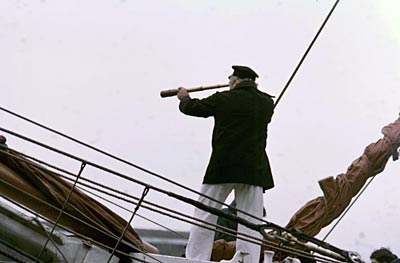 Exeter
Quay became famous in the 1970's as one of the main locations for the
BBC's well loved, Onedin Line. The series, about a ship's master
trading from the Port of Liverpool, captured the imagination of the
nation, with its evocative theme music from the ballet Spartacus, by
Aram Khachaturian. Exeter quayside was used as
the Port of Liverpool - the warehouses dating from 1835, the Custom
House and fish market, and the Prospect
Inn all combined to give the producers an authentic backdrop. Many
locals would hang around, watching the filming during the two periods
of filming. The photographs, were mostly taken by Alan H Mazonowicz and David Reynolds (of Flat Broke Films) during
March 1976, and illustrate how much trouble was taken to decorate the
quay, and remove all modern fixtures to bring the Onedin Line to our
screens. The quay was also used in 1971 for a previous series of the
nautical drama. Exeter
Quay became famous in the 1970's as one of the main locations for the
BBC's well loved, Onedin Line. The series, about a ship's master
trading from the Port of Liverpool, captured the imagination of the
nation, with its evocative theme music from the ballet Spartacus, by
Aram Khachaturian. Exeter quayside was used as
the Port of Liverpool - the warehouses dating from 1835, the Custom
House and fish market, and the Prospect
Inn all combined to give the producers an authentic backdrop. Many
locals would hang around, watching the filming during the two periods
of filming. The photographs, were mostly taken by Alan H Mazonowicz and David Reynolds (of Flat Broke Films) during
March 1976, and illustrate how much trouble was taken to decorate the
quay, and remove all modern fixtures to bring the Onedin Line to our
screens. The quay was also used in 1971 for a previous series of the
nautical drama.
The quayside has undergone many changes since the 1970's making the
area less suitable for filming costume dramas. Therefore, the visit of
the Charlotte Rhodes, and other period sailing ships, in 1976 were a
reminder of the 19th Century port that Exeter had been.
Created by Cyril Abraham, the Onedin Line was first aired on UK
television on 15th October 1971. It ran for 90 episodes over eight
series, with the last episode showing on 26th October 1980. Peter
Gilmore had previously appeared in Carry On, St Trinians and the Doctor
films. Anne Stallybrass played Onedin's wife for 29 episodes and Warren
Clark and Jane Seymour both had their first major roles in the series.
The most famous ship used in the filming was the Charlotte Rhodes, but
a variety of sailing ships was docked at the quay during filming, along
with Brunel's steam dredger, that was normally birthed in the canal basin, as a Maritime Museum exhibit. The producers
also shot many scenes at Dartmouth, Falmouth and Bristol. |
 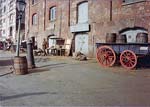 Peter Gilmore as James
Onedin by one of the many carriages that were used in filming the
series - it is not certain whether this was a take or just chatting. Photo Alan H Mazonowicz. A general view of the quay shows James Onedin looking across at his ships berthed off camera. Photo by David Reynolds/Flat-Broke Films. Peter Gilmore as James
Onedin by one of the many carriages that were used in filming the
series - it is not certain whether this was a take or just chatting. Photo Alan H Mazonowicz. A general view of the quay shows James Onedin looking across at his ships berthed off camera. Photo by David Reynolds/Flat-Broke Films.
|
 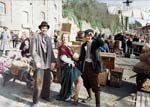 Right - The brothers, Ken
Carpenter, and twins John Carpenter & Alan Carpenter were extras
for the
filming. The beards were real, the seventies
being a bearded era. John Carpenter shaved his beard off after
filming finished, causing his two year old daughter some anguish as she
did not recognise her dad. Photo by Alan H Mazonowicz. The photo left shows three more extras – one is showing some leg. Photo by David Reynolds/Flat-Broke Films. Right - The brothers, Ken
Carpenter, and twins John Carpenter & Alan Carpenter were extras
for the
filming. The beards were real, the seventies
being a bearded era. John Carpenter shaved his beard off after
filming finished, causing his two year old daughter some anguish as she
did not recognise her dad. Photo by Alan H Mazonowicz. The photo left shows three more extras – one is showing some leg. Photo by David Reynolds/Flat-Broke Films.
|
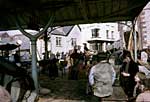 A photo through
the fish-market, with the King's Beam on the left, as they filmed a busy quayside scene. The camera and the
microphone are just to the left of the Prospect Inn, at the centre of
the photograph. Notice the young lads as extras in the foreground. A photo through
the fish-market, with the King's Beam on the left, as they filmed a busy quayside scene. The camera and the
microphone are just to the left of the Prospect Inn, at the centre of
the photograph. Notice the young lads as extras in the foreground.  Two extras sit
in a cart waiting for action, while the film crew mill around, getting
ready for the scene. The hatted extra in the cart was a life insurance
salesman in real life. Two extras sit
in a cart waiting for action, while the film crew mill around, getting
ready for the scene. The hatted extra in the cart was a life insurance
salesman in real life. |
 The cart shown in
the previous photo is shown in this scene, with the two 1835 warehouses
as a backdrop. Many of the extras appear to be hanging around, not
required for this scene. There is a large light on a stand. The cart shown in
the previous photo is shown in this scene, with the two 1835 warehouses
as a backdrop. Many of the extras appear to be hanging around, not
required for this scene. There is a large light on a stand.  The camera is set up
to film some actors walking along the quayside. The camera is set up
to film some actors walking along the quayside.
|
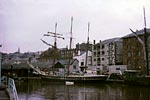 The
Charlotte Rhodes, a three masted schooner, is tied up at the quayside.
She was James Onedin's first ship. The
Charlotte Rhodes, a three masted schooner, is tied up at the quayside.
She was James Onedin's first ship.  I
am not sure if this ship tied up at the quay represents the Anne
Onedin, James Onedin's steam ship in the series. The ship was the
Marquis, with a false funnel. It later became famous when it was
wrecked in the Bristol Channel. I
am not sure if this ship tied up at the quay represents the Anne
Onedin, James Onedin's steam ship in the series. The ship was the
Marquis, with a false funnel. It later became famous when it was
wrecked in the Bristol Channel.
|
  Alan took photographs of
some of the props used in the production. Here posters and barrels have
been placed to add colour to the scene. Alan took photographs of
some of the props used in the production. Here posters and barrels have
been placed to add colour to the scene.
|
 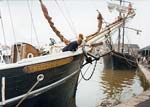 Left – A view of the bow of the Charlotte
Rhodes tied up at the quayside. Photo courtesy Lydia Barnard. Right – the nameplate of the Charlotte Rhodes by David Reynolds/Flat-Broke Films. Left – A view of the bow of the Charlotte
Rhodes tied up at the quayside. Photo courtesy Lydia Barnard. Right – the nameplate of the Charlotte Rhodes by David Reynolds/Flat-Broke Films.
|
 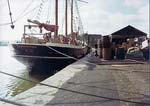 Right – Spectators watch the filming from the
opposite bank. The riverside apartments and Piazza Terracina had not
been built at this time. Photo courtesy Lydia Barnard. Left – The Charlotte Rhodes berthed at the quay. Photo by David Reynolds/Flat-Broke Films. Right – Spectators watch the filming from the
opposite bank. The riverside apartments and Piazza Terracina had not
been built at this time. Photo courtesy Lydia Barnard. Left – The Charlotte Rhodes berthed at the quay. Photo by David Reynolds/Flat-Broke Films.
|
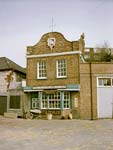 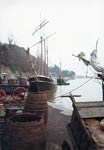 Left – An Exeter quay
building with a few props and change of signs to
indicate a tea dealer. The cameraman would have to choose his angles
carefully to avoid the modern flats on Quay Hill getting into shot. Photo Alan H Mazonowicz. Right – The use of props,carefully placed, helped to add atmosphere to this scene of the quay and the Charlotte Rhodes. Photo by David Reynolds/Flat-Broke Films. Left – An Exeter quay
building with a few props and change of signs to
indicate a tea dealer. The cameraman would have to choose his angles
carefully to avoid the modern flats on Quay Hill getting into shot. Photo Alan H Mazonowicz. Right – The use of props,carefully placed, helped to add atmosphere to this scene of the quay and the Charlotte Rhodes. Photo by David Reynolds/Flat-Broke Films.
|
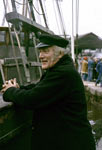  Right – A nice portrait of Howard Lang who played
Captain Baines, one of James Onedin's ships masters. Lang was a well
established character actor who had appeared in many films and TV
series from Great Expectations in 1946, through Z-Cars and his last
appearance in The Pickwick Papers. He died in 1989. Left – Costumed up, this extra poses for the camera. Right – A nice portrait of Howard Lang who played
Captain Baines, one of James Onedin's ships masters. Lang was a well
established character actor who had appeared in many films and TV
series from Great Expectations in 1946, through Z-Cars and his last
appearance in The Pickwick Papers. He died in 1989. Left – Costumed up, this extra poses for the camera.
|
|

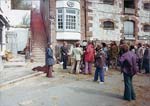 Peter Gilmore
chatting with another cast member between takes. Are the flared
trousers authentic to the Liverpool Docks of the 1800s, or do they
reflect the style of the mid 1970s. Photo Alan H Mazonowicz. Right – Filming a close up of James Onedin below Quay Steps. Photo by David Reynolds/Flat-Broke Films.
Peter Gilmore
chatting with another cast member between takes. Are the flared
trousers authentic to the Liverpool Docks of the 1800s, or do they
reflect the style of the mid 1970s. Photo Alan H Mazonowicz. Right – Filming a close up of James Onedin below Quay Steps. Photo by David Reynolds/Flat-Broke Films. |

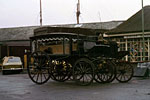 A horse-drawn hearse
complete with coffin on the quayside. It should be possible to work out
which episode it was used in. All the carriages were supplied by Goody
Bros. of Reading. Two carriages for use in
the production are temporarily stored off shot. One of the horses is
enjoying a rest. Two carts are placed against
the warehouses to make the area look like a busy commercial area.
A horse-drawn hearse
complete with coffin on the quayside. It should be possible to work out
which episode it was used in. All the carriages were supplied by Goody
Bros. of Reading. Two carriages for use in
the production are temporarily stored off shot. One of the horses is
enjoying a rest. Two carts are placed against
the warehouses to make the area look like a busy commercial area. |
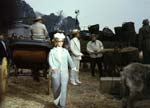 The
glare from the lights was obviously too much for the actress Jessica
Benton, requiring the incongruous wearing of sunglasses in her
Victorian costume between takes. The day was dark, with threatening
snow storms, even though the scene with the donkeys was supposed to be
in the Azores. The
glare from the lights was obviously too much for the actress Jessica
Benton, requiring the incongruous wearing of sunglasses in her
Victorian costume between takes. The day was dark, with threatening
snow storms, even though the scene with the donkeys was supposed to be
in the Azores.
|
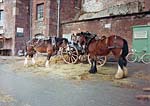 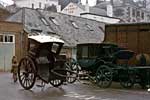 Right – Two of the
horses used to pull the carriage take a break between shots. Judging by
the number of horse drawn vehicles used, there must have been more
horses, unless these two had particularly good acting skills depicting
pulling a hearse, cart or carriage - they had probably been to RADA.
Other animals used at the quay include at least three donkeys. Photo by David Reynolds/Flat-Broke Films. Left are two more of the carriages that were used in the series. Photo Alan H Mazonowicz. Right – Two of the
horses used to pull the carriage take a break between shots. Judging by
the number of horse drawn vehicles used, there must have been more
horses, unless these two had particularly good acting skills depicting
pulling a hearse, cart or carriage - they had probably been to RADA.
Other animals used at the quay include at least three donkeys. Photo by David Reynolds/Flat-Broke Films. Left are two more of the carriages that were used in the series. Photo Alan H Mazonowicz.
|
